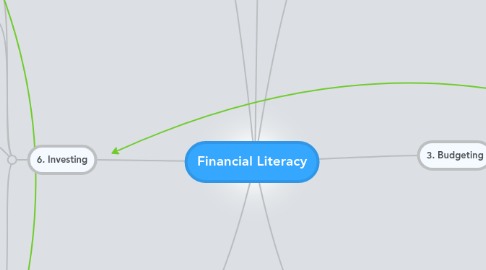
1. 5. Managing debt
1.1. "Good" vs. "bad" debt
1.1.1. Understanding debt and interest rates
1.1.2. Shopping around for the best interest rates
1.1.3. Knowing when to borrow and when not to borrow
1.2. Prioritizing repayment of expensive debt
1.3. Knowing when it's okay to use debt for investments
2. 6. Investing
2.1. Understanding the relationship between risk and return
2.2. Distinguishing between "passive" and "active" investments
2.3. Understanding common types of (passive) investment products
2.3.1. Time deposits
2.3.2. Treasury bills/bonds
2.3.3. Corporate bonds
2.3.4. Stocks
2.3.5. Mutual funds and UITFs
2.3.6. Real estate
2.3.7. Others (such as speculative investments)
2.4. Knowing the important aspects of investing: "SHORE"
2.4.1. Scrutiny
2.4.2. Horizon
2.4.3. Objectives
2.4.4. Risk
2.4.5. Experience
3. 7. Starting and running a business
3.1. Writing a business plan
3.1.1. Realizing key considerations
3.1.1.1. Choosing the appropriate form of organization
3.1.1.1.1. Sole proprietorship
3.1.1.1.2. Partnership
3.1.1.1.3. Corporation
3.1.1.2. Defining your business model. How do you plan to make money?
3.1.1.3. Identifying your market
3.1.1.4. Identifying risks
3.1.1.5. Formulating exit strategies
3.1.2. Evaluating the feasibility of the business
3.2. Raising capital
3.2.1. Your own money
3.2.2. Debt
3.3. Registering your business
3.4. Familiarizing yourself with the different aspects of running a business
3.4.1. Finance - raising capital
3.4.2. Accounting - keeping track of finances
3.4.3. Operations - managing production and processes
3.4.4. Marketing - selling the product
3.4.5. Strategy - making long-term business decisions
4. 2. Defining your financial goal
4.1. Defining "financial freedom"
4.2. "SMART" goal-setting
4.2.1. Specific
4.2.2. Measurable
4.2.3. Attainable
4.2.4. Realistic
4.2.5. Timely
4.3. Knowing where you stand
4.3.1. "Strengths" vs. "weaknesses"
4.3.2. What you own (assets) minus what you owe (liabilities)
4.3.3. What you earn (income) minus what you spend (expenses)
4.4. Knowing your environment
4.4.1. "Opportunities" vs. "threats"
5. 3. Budgeting
5.1. Boosting income
5.1.1. By working more ("sideline")
5.1.2. By investing
5.1.3. By investing in yourself
5.1.3.1. Further studies
5.1.3.2. Certifications
5.1.3.3. Training for new skills
5.2. Controlling expenses
5.2.1. Prioritizing needs over wants
5.2.2. Prioritizing saving over spending
5.2.2.1. Preparing for unforeseeable but necessary future expenses
5.2.2.2. Accumulating capital for investment opportunities
6. 1. Being "financially literate"
6.1. Understanding the importance of financial literacy
6.2. Knowing what you know and what you don't know
6.3. Filling the gaps
6.3.1. Self-learning
6.3.2. Professional training
7. 4. Dealing with life's uncertainties
7.1. Identifying possible future events that may destroy wealth and/or capacity to earn
7.2. Getting insured
7.2.1. Understanding how insurance works
7.2.2. Understanding the different kinds of insurance instruments
7.2.2.1. Term life
7.2.2.2. Health
7.2.2.3. Accident
7.2.2.4. Variable life/"hybrid" insurance products
7.2.3. Government subsidized insurance
7.2.4. Private insurance

